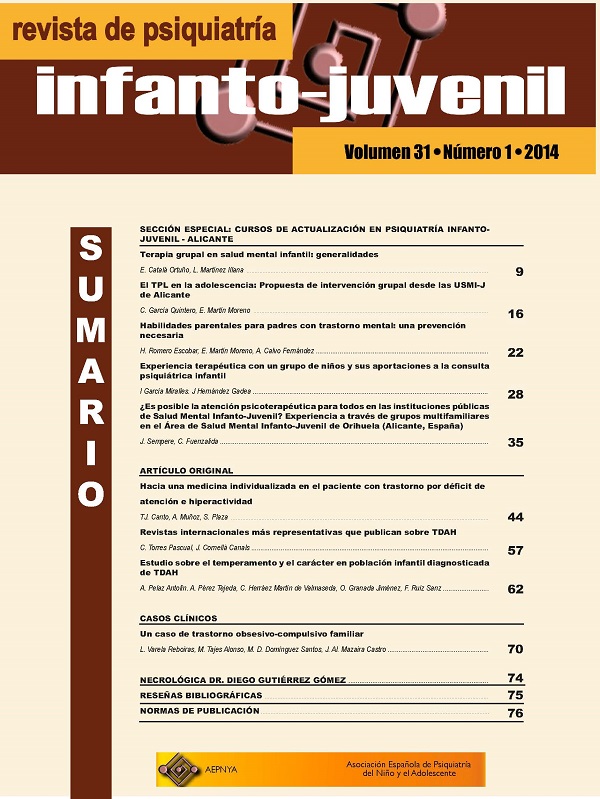El TPL en la adolescencia: Propuesta de intervención grupal desde las USMI-J de Alicante
Descargas
Publicado
Cómo citar
Número
Sección
Palabras clave:
TPL, Adolescencia, Terapia grupalResumen
El Trastorno de Personalidad Límite (TPL), es el más frecuente de los trastornos de personalidad y uno de los más severos por el deterioro global que genera. Presenta una amplia variabilidad sintomática y una elevada comorbilidad, por lo que consume una gran cantidad de recursos sanitarios. El inicio de este trastorno se sitúa en la adolescencia tardía, por lo que las unidades de salud mental infanto-juvenil (USMI-J) juegan un papel relevante en el diagnóstico e intervención precoces. En este artículo describimos la clínica, las dificultades para un diagnóstico precoz y controversias acerca del mismo, a pesar de que en la investigación reciente es cada vez más aceptado. Posteriormente se describen las intervenciones psicológicas más relevantes que han mostrado eficacia para el TPL y su adaptación a la población adolescente. Destacamos iniciativas desarrolladas en nuestro país, sobre todo a nivel de terapia grupal combinada con la individual y por último se propone una intervención grupal específica para mejorar el tratamiento que reciben en las USMI-J de Alicante.
Descargas
Citas
2. Middleton A. Differentiating adolescents with borderline personality disorder from normal adolescents and adolescents with other disorders. The University of Texas at Austin 2004.
3. American Psychiatric Association. DSM-IV-TR. Manual diagnóstico y estadístico de los trastornos mentales (4.ª ed. rev.). Washington, American Psychiatric Association. Barcelona: Masson, 2002.
4. Chanen AM, Jackson HJ, McGorry PD, Allot KA, Clarkson V, Yuen HP. Two-year stability of personality disorder in older adolescent outpatients. J Pers Disord. 2004;18:526-41.
5. Miller A, Muehlenkamp J y Jacobson C. Fact or fiction: Diagnosing borderline personality disorder in adolescents. Clinical Psychology Review 2008; 28, 969-981.
6. Salters-Pedneault, K. Borderline personality adolescents. Health’s Disease and Condition 2008.
7. Zanarini MC, Frankenburg FR, Hennen J, Silk KR. The longitudinal course of borderline psychopathology: 6-year prospective follow-up of the phenomenology of borderline personality disorder. Am J Psychiatry. 2003; 160:274-83.
8. Paris J, Brown R, Nowlis D. Long-term follow-up of borderline patients in a general hospital. Compr Psychiatry 1987;28:530-5.
9. Lyons-Ruth. Borderline symptoms and suicidality/self-injury in late adolescence: Prospectively observed relationship correlates in infancy and childhood Psychiatry Research 2013; 273–281.
10. Sharp C. Theory of mind and emotion regulation difficulties in adolescents with borderline traits. J Am Acad Child Adolesc Psychiatry 2011;50:563-73.
11. Washburn. Psychotherapeutic approaches to nonsuicidal self-injury in adolescents Child and Adolescent Psychiatry and Mental Health 2012; 6:14.
12. Linehan MM. Skills training manual for treating borderline personality disorder. New York, NY (US): Guilford Press; 1993.
13. Miller A, Rathus J, Linehan M, Wetzler S, Leigh E. Dialectical behavior therapy adapted for suicidal adolescents. J Pract Psychiatry Behav Health 1997;3:78-86.
14. MacPherson H. Dialectical Behavior Therapy for Adolescents: Theory, Treatment Adaptations, and Empirical Outcomes Clin Child Fam Psychol Rev 2013; 16:59–80.
15. Woodberry KA, Gallo KP, Nock MK. An experimental pilot study of response to invalidation in young women with features of borderline personality disorder. Psychiatry Res. 2008;157:169–180.
16. James A, Winmill L, Anderson C, & Alfoadari K. A preliminary study of an extension of a community dialectic behaviour therapy (DBT) programme to adolescents in the looked after care system. Child and Adolescent Mental Health 2011; 16, 9–13.
17. Shelton D, Kesten K, Zhang W & Trestman R. Impact of dialectical behavior therapy—Corrections modified (DBT-CM) upon behaviorally challenged incarcerated male adolescents. Journal of Child and Adolescent Psychiatric Nursing 2011; 24,105–113.
18. Marieke Schuppert Effectiveness of an Emotion Regulation Group Training for Adolescents—a Randomized Controlled Pilot Study Clin. Psychol. Psychother 2009;16, 467–478.
19. Soler J, Pascual JC,Tiana T, Cebria A, Barrachina J, Campins MF, Gich I, Álvarez E y Pérez V Dialectical behaviour therapy skills training compared to standard group therapy in borderline personality disorder: A 3-month randomised controlled clinical trial. Behaviour Research and Therapy, 2009;47, 353-358.
20. Santiago, S. Tratando... inestabilidad emocional, Terapia Icónica. Madrid: Pirámide 2008.
21. Fórum de Salud Mental y AIAQS, coordinadores. Guía de práctica clínica sobre trastorno límite de la personalidad. Barcelona: Agència d’Informació, Avaluació i Qualitat en Salut. Servei Català de la Salut. Pla Director de Salut Mental i Addiccions. Departament de Salut. Generalitat de Catalunya; 2011.





 © 2021 AEPNyA Todos los derechos reservados
© 2021 AEPNyA Todos los derechos reservados
